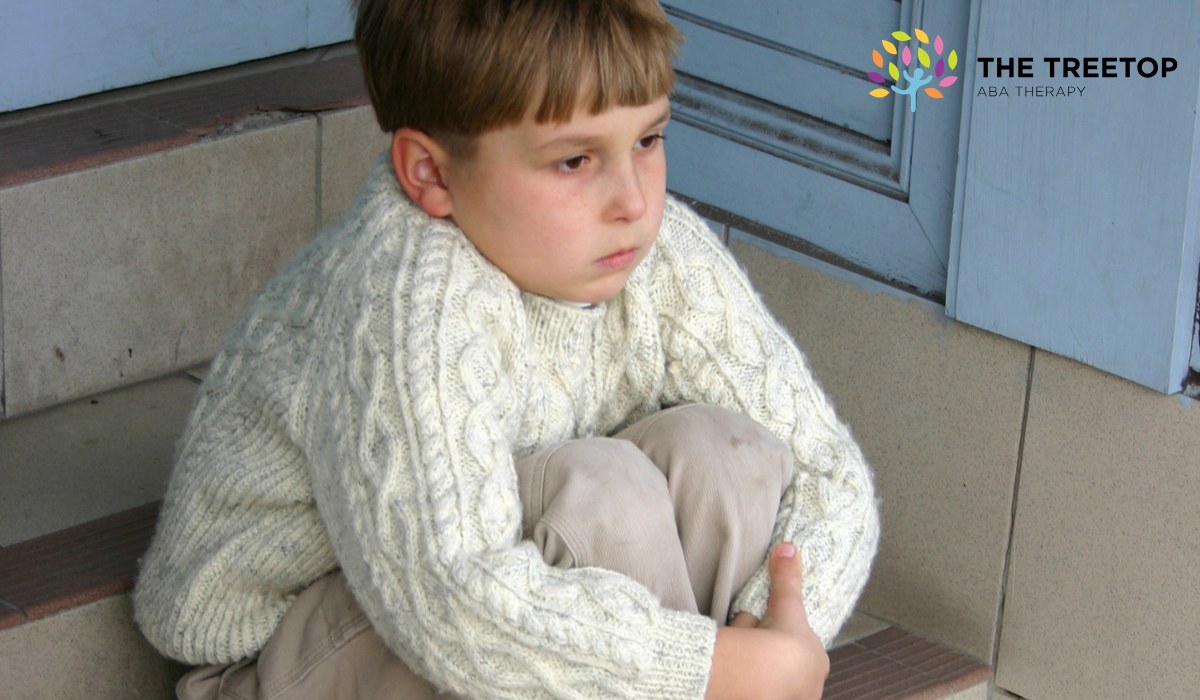Autistic Shutdowns: Signs, Causes & How to Respond

Written By:
Fact-checked By:
November 18, 2025
Autistic shutdowns often follow sensory overload or stress. Discover common signs, causes, and supportive ways to help during these moments.

Key Points:
- Autistic shutdowns often happen due to sensory overload, stress, or emotional overwhelm and can look very different from person to person.
- Recognizing the signs early and responding with patience and supportive strategies helps your child recover safely.
- ABA therapy can provide structured ways to manage triggers and develop coping skills, improving daily functioning and well-being.
Autistic shutdowns can be confusing and concerning for parents, especially when they occur suddenly. Unlike meltdowns, which often involve outward expressions of distress, shutdowns tend to be quieter, inwardly directed, and sometimes misunderstood. They occur when a child’s brain becomes overwhelmed—often by sensory input, social demands, or emotional stress—and essentially “shuts down” to protect itself. Understanding the signs, causes, and practical ways to respond is essential for keeping your child safe, comfortable, and supported.
What is an Autistic Shutdown?
Before diving into the causes and signs, it’s important to understand what a shutdown actually is. Autistic shutdowns are periods of reduced responsiveness, where your child may withdraw from their environment, stop talking, or appear “frozen.” This is a coping mechanism—a way for the nervous system to recover from overwhelm.
Shutdowns can vary widely: some children may retreat to a quiet space, others may stop interacting but continue with minimal movement, and some may even lose certain motor functions temporarily. Unlike tantrums or meltdowns, which are often outwardly visible, shutdowns are subtle and easily missed if you don’t know what to look for.
Common Signs of Autistic Shutdowns
Recognizing the early signs of a shutdown is key to helping your child avoid prolonged stress. These signals may appear gradually or suddenly, and they can differ for each child.
Here are some common indicators:
1. Withdrawal from Interaction
Your child may stop speaking, avoid eye contact, or pull away from physical touch. They may no longer respond to their name or to prompts from caregivers.
2. Reduced Movement or “Freezing”
Some children may become almost motionless, sitting quietly in one spot or hugging themselves. Fine motor skills can also be affected, making it hard to hold objects or perform tasks that are usually easy.
3. Sensory Avoidance
Shutdowns often follow sensory overload. Children may cover their ears, squint, or avoid certain textures or lights. They may also resist being touched, even gently.
4. Emotional Numbing
A shutdown can look like emotional flatness—your child may appear “spaced out” or disconnected. This is their brain’s way of managing overwhelming feelings.
5. Temporary Loss of Skills
Some children may temporarily lose the ability to speak, follow routines, or engage in previously learned skills. This is usually short-lived, but it can be distressing for parents.
By observing these signs closely, you can intervene early and prevent the shutdown from escalating or lasting longer than necessary.
What Causes Autistic Shutdowns?
Understanding why shutdowns occur helps parents and caregivers create environments that reduce stress and support recovery. While each child’s triggers are unique, common causes include:
1. Sensory Overload
Autistic children often process sensory information differently. Bright lights, loud sounds, crowded spaces, or certain textures can become overwhelming, triggering a shutdown.
2. Emotional or Social Stress
High-pressure social situations, unexpected changes in routine, or conflict with peers or family can lead to emotional overwhelm. Shutdowns can serve as a protective mechanism when a child feels unable to cope.
3. Cognitive Fatigue
Tasks that require intense focus, problem-solving, or multi-step thinking can sometimes push a child’s mental resources beyond their limit. This cognitive fatigue can manifest as a shutdown.
4. Accumulated Stress
Even smaller stressors can build up over time. Lack of sleep, hunger, illness, or emotional tension can accumulate until the child reaches a threshold that triggers a shutdown.
5. Sensory and Emotional Interactions
Often, shutdowns result from a combination of sensory and emotional factors. For instance, a noisy classroom plus a challenging social interaction may overwhelm the child more than either factor alone.
By identifying triggers, parents and caregivers can help reduce the frequency and intensity of shutdowns. ABA therapy programs can help children develop coping strategies for these exact situations, building resilience and self-regulation.

How to Respond During a Shutdown
When a shutdown occurs, your response can make a big difference in your child’s comfort and recovery. Immediate reactions should prioritize safety, calm, and support. Here’s a guide:
Step 1: Stay Calm and Patient
Your calm presence reassures your child that the environment is safe. Avoid scolding, demanding attention, or forcing interaction. Remember, shutdowns are not intentional misbehavior.
Step 2: Create a Low-Stimulation Environment
Move your child to a quiet, dimly lit space if possible. Reduce background noise, bright lights, and other sensory inputs that may worsen overwhelm.
Step 3: Offer Comfort, Not Pressure
Gentle reassurance can help, but let your child set the pace. Some children benefit from soft touch or a weighted blanket, while others need complete personal space. Watch their cues carefully.
Step 4: Use Minimal Communication
Avoid asking too many questions or expecting responses. Simple, calm statements like “I’m here” or “Take your time” are better than asking “What’s wrong?”
Step 5: Support Recovery Through Routine
Once the shutdown passes, gradually reintroduce familiar routines or low-demand activities. Reinforce any attempts to communicate or engage positively, even subtly.

5 Strategies to Prevent Shutdowns
Prevention is always better than reaction. Consistent strategies can reduce the frequency and severity of shutdowns. Consider these approaches:
1. Structured Routine
Predictable schedules help children anticipate transitions and reduce anxiety. Visual schedules, timers, and clear expectations can support this structure.
2. Sensory Breaks
Incorporate regular breaks to allow your child to self-regulate. Activities like deep pressure exercises, quiet play, or using noise-canceling headphones can help manage sensory input.
3. Coping Skill Development
Teaching children tools like deep breathing, fidget objects, or simple self-soothing techniques can reduce overwhelm before it leads to a shutdown.
4. Environmental Adjustments
Adjust lighting, noise levels, or seating arrangements to reduce sensory triggers. Sometimes small changes in the home or classroom environment can prevent significant stress.
5. Positive Reinforcement
Rewarding self-regulation, asking for breaks, or using coping strategies can encourage your child to practice adaptive responses proactively. ABA therapy often structures these reinforcements systematically to maximize learning.
When to Seek Professional Support
Not all shutdowns require medical attention, but frequent, prolonged, or severe shutdowns may signal a need for additional support. Consider consulting professionals if:
- Shutdowns happen multiple times per week and interfere with daily activities.
- Your child experiences intense anxiety or distress before or after shutdowns.
- The shutdowns result in self-injury or extreme withdrawal.
- You notice sudden changes in behavior, communication, or daily functioning.
A BCBA or other qualified therapist can assess triggers, teach coping strategies, and help integrate these skills into daily routines.

How ABA Therapy Helps With Shutdowns
Applied Behavior Analysis (ABA) therapy can be a valuable tool for children who experience shutdowns. ABA programs focus on understanding triggers, teaching coping strategies, and reinforcing adaptive behaviors. Here’s how ABA supports children during and after shutdowns:
- Identifying Triggers – Therapists systematically observe and record what environmental or emotional factors lead to shutdowns.
- Teaching Coping Skills – Children learn to use self-regulation tools before overwhelm escalates, such as requesting breaks or engaging in calming activities.
- Reinforcing Positive Responses – Through structured reinforcement, children gain confidence in using adaptive strategies instead of withdrawing.
- Collaborating With Families – ABA therapists work closely with parents to generalize skills across home, school, and community settings.
Treetop ABA Therapy integrates these strategies into individualized programs, helping children build resilience, manage stress, and navigate daily challenges with greater independence.
Supporting Your Child at Home
Parents play a crucial role in helping children recover from or prevent shutdowns. Practical, day-to-day support includes:
- Observing Patterns – Track when and where shutdowns occur to identify triggers.
- Creating Calm Spaces – Dedicate a low-stimulation area at home where your child can retreat safely.
- Modeling Self-Regulation – Show coping strategies yourself, such as taking deep breaths or stepping away when stressed.
- Encouraging Communication – Use visuals, gestures, or simple words to help your child express needs without pressure.
- Maintaining Consistency – Reinforce routines, sleep schedules, and predictable daily structures.
Even small, consistent steps can reduce the stress that leads to shutdowns and help your child feel secure.
Supporting Your Child Through Autistic Shutdowns with ABA Therapy
Autistic shutdowns can feel overwhelming, but understanding the signs, causes, and supportive strategies allows parents to respond with compassion and confidence. By recognizing early indicators, reducing sensory and emotional triggers, and teaching coping skills, you can help your child manage moments of overwhelm safely and positively.
ABA therapy, like the programs offered by Treetop ABA Therapy, provides structured, evidence-based support in a nurturing environment. These programs help children identify triggers, develop self-regulation strategies, and reinforce adaptive behaviors, giving them the tools to navigate daily life with greater confidence. Families seeking ABA therapy in Oklahoma, Arizona, New Mexico, Georgia, or Colorado can benefit from programs that focus on both preventing and responding to shutdowns, empowering children to thrive.
If you’d like guidance and support for your child through autistic shutdowns, get in touch with us. Our team is ready to help strengthen coping skills, reduce stress, and encourage meaningful progress in everyday routines—contact us today to learn more.
Similar articles
Reaching New Heights With The TreeTop ABA Therapy
Our mission is to help improve the lives of children with ASD and their families with home and community based ABA therapy.

